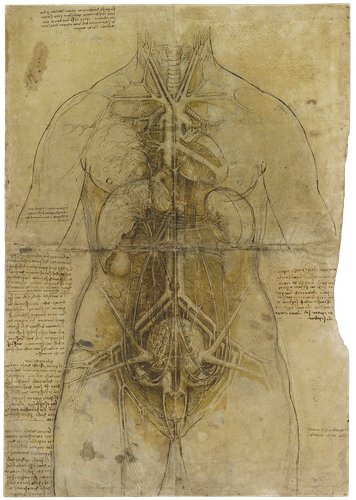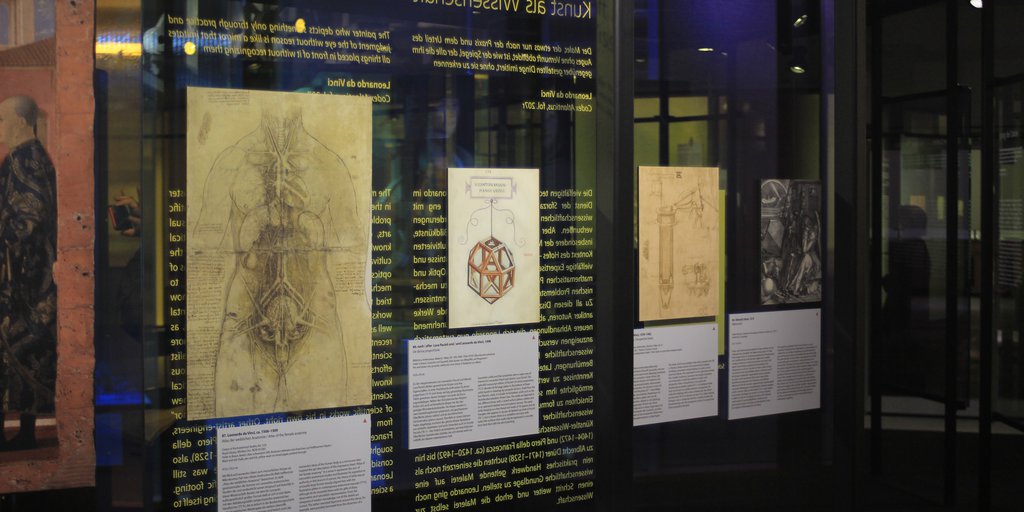
Science as Art, Art as Science <
The painter who depicts something only through practice and judgment of the eye without reason is like a mirror that imitates all things
placed in front of it without recognizing them
Leonardo da Vinci
Codex Atlanticus, fol. 207r. Translation: Elizabeth Hughes
The many and varied technical tasks Leonardo had to master in the service of the Sforzas were closely linked to scientific problems and challenges. But also the practice of the visual arts, especially painting, increasingly required theoretical knowledge and diverse expertise, particularly in the cultivated context of the court. This ranged from questions of optics and mathematical perspective construction to mechanical problems and medical knowledge. Leonardo now tried to learn systematically from the existing fundamental works by ancient authors related to all these disciplines, as well as from medieval sources and a growing number of more recent treatises. He expanded his library with specialist scientific literature and made concentrated and ambitious efforts to learn Latin and deepen his mathematical knowledge. This eventually enabled him to formulate new scientific insights of his own. He had now become an “author” of scientific works in his own right. Other artist-engineers, from Leon Battista Alberti (1404–1472) and Piero della Francesca (ca. 1420–1492) to Albrecht Dürer (1471–1528), also sought to place painting, which at the time was still considered a purely practical craft, on a scientific footing. Leonardo went one step further and elevated painting itself to a science.
Anatomy and Surgery <
 | 87.
Atlas of the female anatomy ca. 1508–1509 |

Leonardo’s ideas of the human body as a microcosm later inspired the apt description of this impressive sheet: “Atlas of the female anatomy.” In a sense it represents the sum of Leonardo’s anatomical studies and illustrates his aspiration to authority in this branch of science. His choice of what was an unusually large format already aligned him with the illustration plates in contemporary anatomical manuals (77 ■), although he far exceeded them with his gifts of sharp observation and naturalistic representation. From the viewpoint of modern knowledge, not all the details are correct. The rather oversized ligaments around the uterus, for example, were possibly borrowed from the dissection of a cow.
References
Bambach, Carmen C. 2019. Leonardo da Vinci Rediscovered. Vol. 3: The Late Years 1506–1519. 4 vols. New Haven / London: Yale University Press, 182–196.
Clayton, Martin. 2019. Leonardo da Vinci. A Life in Drawing. 200 Works from the Royal Collection. Exhibition catalogue, The Queen’s Gallery, London, 24.5.–13.10.2019, The Queen’s Gallery, Palace of Holyroodhouse, Edinburgh, 22.11.2019–15.2.2020. London: Royal Collection Trust, 162, no. 132.
Clayton, Martin, and Ronald Philo. 2010. Leonardo da Vinci. The Mechanics of Man. Exhibition catalogue Vancouver Art Gallery, Canada, 6.2.–2.5.2010. London: Royal Collection Trust.
Laurenza, Domenico. 2006. In La mente di Leonardo. Nel laboratorio del Genio Universale. Exhibition catalogue Galleria degli Uffizi, Florence, 28.3.2006–7.1.2007, edited by Paolo Galluzzi. Florence: Giunti, 108–109.









